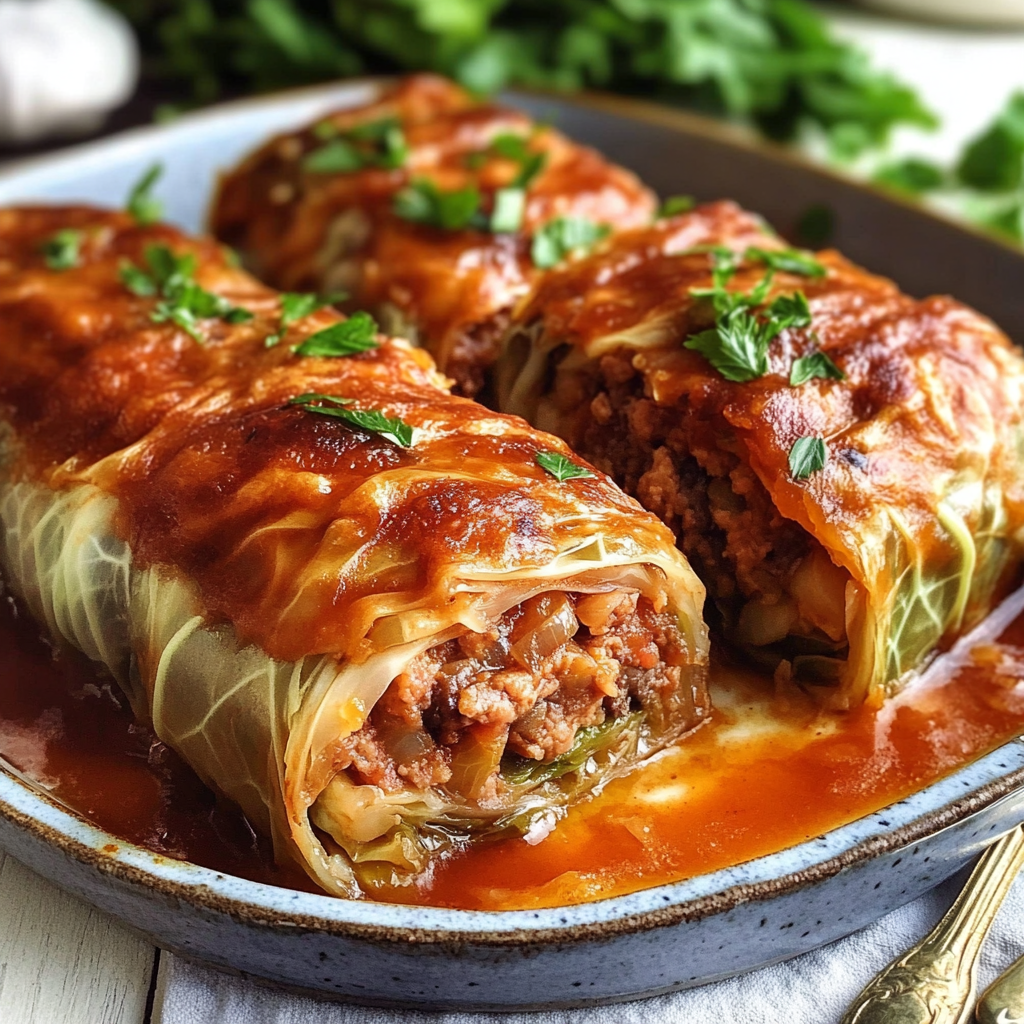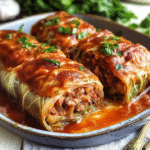🥬 Introduction to Stuffed Cabbage Rolls
Few dishes offer the comfort and heritage of a warm plate of stuffed cabbage rolls. This timeless recipe wraps savory, seasoned fillings in tender cabbage leaves, then slow-simmers the bundles in a rich tomato or cream-based sauce. The result is a dish that’s both hearty and elegant—perfect for cozy family dinners or festive gatherings. Whether you know them as Gołąbki, Töltött Káposzta, or Golubtsy, these rolls have deep roots in Eastern European kitchens but have found global popularity due to their comforting flavor and adaptability.
Stuffed cabbage rolls are traditionally made with a mixture of ground meat (commonly pork, beef, or turkey), rice or grains, onions, and aromatic spices. The softened cabbage leaves act as a natural wrapper, locking in moisture and flavor. What makes this dish shine is its balance: the savory meat, the subtle sweetness of the tomato sauce, and the slight tang from ingredients like sauerkraut or sour cream.
Like a classic beef stew, this is a meal that feels like home, no matter your background. From holiday tables to weeknight staples, stuffed cabbage rolls continue to be reimagined in kitchens worldwide, blending tradition with personal creativity and local ingredients.
📜 What Are Stuffed Cabbage Rolls?
Stuffed cabbage rolls are made by wrapping boiled cabbage leaves around a filling—usually a mix of ground meat, rice, onion, and seasonings—and then simmering the bundles in a rich tomato sauce. The final result is a melt-in-your-mouth dish with layers of savory, sweet, and sometimes tangy flavor.
From Hungarian sauerkraut-layered versions to Polish Golabki and Russian Golubtsy, each culture puts its own spin on this dish. You can explore their full cultural history here to understand just how far these humble rolls have traveled.
Cabbage itself is not just a wrapping agent—it’s a versatile, nutritious vegetable when prepared correctly. If you’ve ever struggled to get the texture just right, here’s a complete guide to cooking cabbage perfectly.
🌍 A Brief History & Cultural Roots
Stuffed cabbage rolls date back to ancient Middle Eastern cuisines, believed to have spread through trade and migration into Eastern Europe and beyond. Over time, they adapted to regional tastes:
- Poland (Gołąbki): Mild tomato sauce with pork and rice filling
- Hungary (Töltött Káposzta): Paprika-seasoned pork with sauerkraut layered throughout
- Russia (Golubtsy): Ground meat and rice wrapped in cabbage and topped with a creamy tomato sauce
- Jewish Cuisine: Sweet and sour tomato sauce with raisins or brown sugar
- Middle East: Vegetarian or spiced rice and lamb filling, often served with yogurt sauce
🧾 Core Ingredients You Need
At the heart of stuffed cabbage rolls lies a simple yet flavorful combination of ingredients that deliver both texture and taste. Each component plays a distinct role in achieving that satisfying bite.
- Cabbage: The outer leaves of green cabbage are most commonly used due to their durability and flexibility when boiled. Savoy cabbage offers a more delicate, tender option.
- Ground Meat: Pork, beef, turkey, or a combination thereof forms the savory base. The meat provides richness and binds well with rice when cooked.
- Rice or Grains: White rice is traditional, adding body and balance to the meat. Substitutes like brown rice, bulgur, or quinoa offer modern twists.
- Aromatics: Onions and garlic enhance the depth of flavor, while spices like sweet paprika, marjoram, and black pepper bring cultural authenticity—especially in Hungarian versions.
- Tomato Sauce & Sauerkraut: The sauce infuses moisture and tang. In some styles, a layer of sauerkraut between rolls adds acidity and complexity.
Each ingredient contributes to the roll’s hearty character, making this dish a customizable canvas for both tradition and creativity.
🍲 How to Make Traditional Stuffed Cabbage Rolls
Step-by-Step Instructions
- Prepare the cabbage:
- Boil a head of green cabbage for 10–15 minutes to soften.
- Peel leaves gently and set aside.
- Cook the filling:
- Sauté onions and garlic in olive oil.
- In a bowl, mix ground meat, cooked rice, eggs, paprika, onions, garlic, salt, and pepper.
- Roll the cabbage:
- Place filling in the center of each leaf.
- Tuck in sides and roll like a burrito.
- Layer and cook:
- Place a layer of rinsed sauerkraut in a Dutch oven.
- Add cabbage rolls on top.
- Pour tomato sauce (puree mixed with water) over rolls.
- Simmer:
- Cover and simmer on low for 60–90 minutes.
- Sauce it up:
- Remove rolls.
- Stir sour cream into the remaining sauerkraut and tomato mixture for a creamy finish.

🧂 Popular Traditional Variations
Stuffed cabbage rolls have traveled through generations and across borders, with each region leaving its flavorful mark on this classic dish. While the core concept remains the same—cabbage leaves filled with meat and rice—the variations are rich in cultural nuance.
- Polish Gołąbki: Often filled with a mix of ground pork and beef, and simmered in a slightly sweet tomato sauce, this version is a staple at holidays and family dinners.
- Hungarian Töltött Káposzta: Known for its bold flavors, it features paprika-seasoned pork and is layered with sauerkraut for added tang, often served with sour cream.
- Russian/Ukrainian Golubtsy: A milder roll, commonly cooked in tomato sauce or a tomato-cream gravy, and served with sour cream.
- Jewish Sweet-and-Sour Rolls: These include raisins or brown sugar in the tomato sauce, offering a sweet-savory balance.
- Romanian Sarmale: Typically uses smoked meats and herbs, and sometimes grape leaves instead of cabbage.
These variations reflect local tastes, traditions, and available ingredients, showing how one humble dish can adapt while preserving its cultural soul.
🌶 Modern & Global Twists
While stuffed cabbage rolls are rooted in tradition, their versatility has inspired chefs and home cooks around the world to develop innovative, globally influenced versions. These modern adaptations retain the comforting essence of the dish while introducing bold flavors, creative fillings, and new cooking methods.
- Moroccan-Spiced Rolls: Swapping out traditional pork for ground lamb and seasoning the filling with cumin, coriander, and cinnamon gives the dish a North African twist. These rolls are often paired with a harissa-tomato sauce for added heat.
- Middle Eastern Vegetarian Rolls: Rice, lentils, toasted almonds, and spices like allspice and sumac are wrapped in cabbage and served with a mint-yogurt sauce. This variation is both hearty and plant-based.
- Turkey-Stuffed Light Rolls: Lean ground turkey and brown rice make this a lower-fat, high-protein version, great for healthy weeknight meals.
- Vegan & Plant-Based Rolls: Modern eaters are turning to mushrooms, quinoa, and lentils as filling alternatives, producing rich umami flavor without meat.
- Cabbage Roll Casserole: A deconstructed take on the original, this version layers chopped cabbage, filling, and sauce in a baking dish—perfect for busy cooks.
- Cabbage Roll Soup: All the flavors of the original, simplified into a one-pot meal ideal for cold weather.
- Fusion Rolls: From Asian-style rolls with hoisin glaze to Mexican-inspired cabbage tamales, creative spins continue to push culinary boundaries.
These global interpretations not only make the dish more accessible but also demonstrate how food traditions evolve while keeping their comforting soul intact. Health benefits of adding sauerkraut.
Print
Stuffed Cabbage Rolls
- Total Time: 1 hour 55 minutes
- Yield: 6 servings 1x
Description
Tender cabbage leaves filled with savory meat and rice, simmered in a tangy tomato sauce. A traditional comfort food with global roots.
Ingredients
- 1 large head green cabbage
- 1 lb ground pork (or beef/turkey)
- ¾ cup cooked white rice
- 1 cup chopped onion
- 2 cloves garlic (minced)
- 2 large eggs (beaten)
- 1 tsp salt (½ tsp pepper)
- 2 tbsp sweet Hungarian paprika
- 1 tsp dried marjoram (or oregano)
- 1 cup tomato purée + 1 cup water
- 2 cups sauerkraut (optional layer)
- 1 cup sour cream (optional sauce finish)
- 2 tbsp olive oil
Instructions
- Prepare the Cabbage: Boil the whole cabbage for 10–15 mins until leaves are pliable. Peel and set aside.
- Make the Filling: Mix ground meat, rice, onion, garlic, eggs, and seasonings in a bowl.
- Roll the Cabbage: Place filling in each leaf, fold in sides, and roll tightly.
- Layer & Sauce: Line the bottom of a Dutch oven with sauerkraut (optional), place rolls, and pour tomato-water mixture on top.
- Cook: Cover and simmer for 1 hour or bake at 350°F for 75 minutes.
- Finish (Optional): Remove rolls, stir sour cream into sauce, return rolls, and serve warm.
Notes
-
Use Savoy cabbage for softer texture.
-
Rolls can be frozen before or after cooking.
-
To make it dairy-free, skip the sour cream finish.
-
Add crushed red pepper for a spicy variation.
- Prep Time: 25 minutes
- Cook Time: 1 hour 30 minutes
- Category: Main Course
- Cuisine: Eastern European
Nutrition
- Calories: 480
🔪 Cooking Methods: Which One’s Best?
- Stovetop Simmering: Best for rich, deep flavors
- Oven Baking: Even heat and reduced cleanup
- Instant Pot: Quick and easy under pressure
- Slow Cooker: Set it and forget it
Tip: Try wrapping filling in bread dough instead of cabbage for a fun twist!
✔️ Tips for Perfect Cabbage Rolls
- Use large outer cabbage leaves for easier rolling
- Boil whole cabbage for easier peeling
- Don’t overstuff rolls—leave space to fold
- Freeze individually before cooking for easy prep
- Use sweet Hungarian paprika for authentic flavor
- Mix meats (pork + beef) for a balanced taste
- Add sauerkraut between layers for extra tang
FAQs About Stuffed Cabbage Rolls ❓
Can I freeze stuffed cabbage rolls?
Yes! Freeze before cooking for up to one month. Thaw in fridge before simmering.
What’s the best cabbage for rolling?
Green cabbage is best. For tender leaves, try Savoy.
How do I keep cabbage leaves from tearing?
Boil or steam whole cabbage first and cool before peeling.
Can I make them ahead?
Absolutely. Assemble the day before and refrigerate or freeze.
How long should I cook cabbage rolls?
Simmer for 60–90 minutes or bake for 1 hour at 350°F.
What’s the healthiest version?
Use lean meats, go easy on rice, and try a tomato-only sauce instead of cream.
🥗 Nutritional Snapshot
Typical cabbage rolls (with pork and rice) provide:
- Calories: ~500 per serving
- Protein: ~30g
- Carbs: ~35g
- Fat: ~30g
Lighten it up with:
- Turkey or chicken
- Cauliflower rice
- Tomato-only sauces
🍽 Serving Ideas
Pair your stuffed cabbage rolls with:
- Mashed potatoes or root veggie mash
- Rye or sourdough bread
- Creamy cucumber salad
- Roasted carrots or beets
For wine lovers: A dry Riesling or light red like Pinot Noir pairs well.
🌟 Final Thoughts
Stuffed cabbage rolls are the ultimate comfort food—whether you’re sticking with the Hungarian classic or trying a Moroccan-spiced lamb version. They’re nourishing, satisfying, and endlessly customizable. Add them to your weekly meal prep, holiday dinners, or freezer stash—you won’t regret it.
Looking to explore more cabbage magic? Don’t forget to check out these creative cabbage cooking ideas and health perks of sauerkraut to round out your knowledge.



